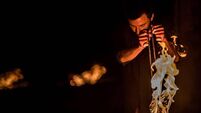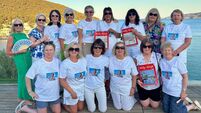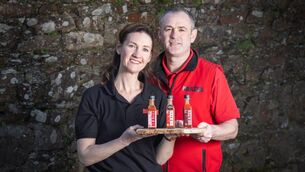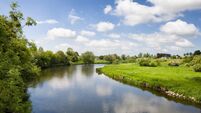A wave of pure emotion: Artistic Cork couple tell story of Lusitania memorial

PLACE OF REFLECTION: The Lusitania Memorial Garden at the Old Head of Kinsale which was officially opened earlier this month
EVEN more than a century later, the sinking of the Lusitania off Cork’s waters has the power to move people.
It’s hard to believe that 1,198 passengers and crew died within minutes that day in 1915 after the vessel was torpedoed by a German U-boat — but it is the individual stories that resonate the most.
One of the crew, Able Seaman Joseph Parry, helped to save around 100 people from the waters 11 miles off the Old Head of Kinsale.
The sailor, from Liverpool, survived the tragedy and for the rest of his life, he kept a leather baby shoe which he had been given to a grateful mother after he had hauled her and her baby into a rescue boat.
Sadly, both had subsequently died and on this little shoe, Parry had written the name Lusitania, the date of the sinking — May 7, 1915 — and the words ‘Lest We Forget’.
Poignantly, those words now take pride of place in the new Lusitania memorial in Kinsale unveiled last month by Minister Simon Coveney. They appear within a lifebuoy carved into a sculpture called The Wave.
This Wave sculpture was the work of Cork husband and wife artists, Liam Lavery and Eithne Ring.
The 20 metre long bronze sculpture lists all the names of those on board the Lusitania en route from New York to Liverpool 102 years ago and Liam explains how they obtained the commission.
“We made the shortlist of five artists,” he says. “We saw the garden and the brief was to include all the names of the passengers who sailed on the Lusitania when it sank.
“The contemporary artistic feature was a prestigious commission, enabling us to showcase all our talents.”
Liam is from Dromina, near Charleville, and Eithne is from Knockadoon, East Cork.
“It helped that we knew the Old Head of Kinsale well,” says Eithne. “The location resembles Knockadoon in many ways.”
She recalls where she and her husband were when they learned they had got the job. “At home in Charleville, drinking coffee!” says Eithne. “We were absolutely thrilled. We knew we could do it.”
The sculpture was two years in the making. It was cast in a foundry in Cornille-Harvard in Normandy, France, which also cast the new bells for the Notre Dame Cathedral in Paris in 2002.
“It was a labour of love and a unique experience,” says Liam. “We put our heart and soul into it. It was our baby.”
When was the idea of The Wave born? “The idea of the Wave came to us very quickly,” says Liam, as we walked around the commemorative garden where the symbolic sculpture takes pride of place.
The 20-metre sculpture curves around a section of the perimeter of the garden. Each name on it is accompanied by the symbol of a life buoy or a cross in a wave depicting their fate.a cross in a wave depicting their fate.
All the victims, from more than 30 nationalities, are recorded alphabetically.
The surface background is very rough in texture and depicts bits of wreckage, seaweed, crustaceans and fishing nets.

The ten continuing panels on the sculpture explain the tragic story in fine detail of the great liner on its fateful last journey.
“It is not a very dramatic wave,” explains Liam, speaking about the undulating curve of the sculpture. “Because the day the Lusitania sank, it was quite calm.
“We knew that we wanted to do a horizontal piece and we wanted all the names to go up and down as if they were carved along the fluidity of the water.
“We worked with the foundry in France using the traditional sand casting technique. The reason for using this foundry was its ability to cast large panels in one piece without any welding and retain the level of detail that was in the original design.
“Their enthusiasm for the project propelled us on and continued to motivate us. Immediately they said, yes, we want this job. We were back and forth to France all the time.
“On our last day at the foundry there, the locals came to see the piece and the chef from the local restaurant came with his wife to take photographs.”
Everyone was enthused by the project.
“We had huge support from the local Courceys and Kinsale communities as well as the Lusitania Museum/Old Head Signal Tower Heritage,” adds Liam.
Eithne is no stranger to foundries. “My late dad had a small foundry in Knockadoon where I grew up,” she says.
“His work was the very same as the work done in the Cornille-Harvard in France. He would love to have seen the sculpture coming together.”
Eithne’s mother has artistic talent too. She likes to paint,” says Eithne, who also enjoyed drawing as a child. “I was never without pen and paper,” she adds.
Liam got the artistic genes too.
“My mother loved to paint and she used to make jewellery,” he says.
The couple have been working in public art for more than 20 years.
“My very first commission was to create a mural for a tea-room in Jersey,” says Eithne.
A lot of in-depth research and ingenuity was involved in creating The Wave.
It shows the Lusitania depicted leaving Pier 54 in Manhattan’s West Side and making her way down the Hudson River past the New York skyline as it looked in 1915.







 App?
App?


